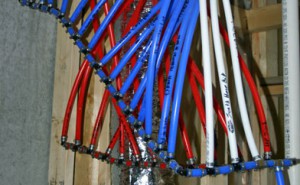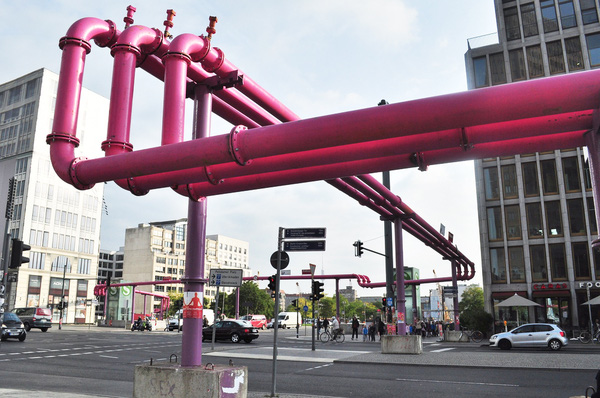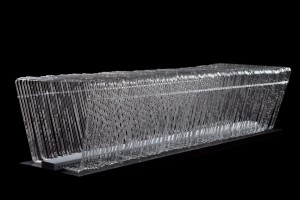“You need to create possibilities to store the water when there is a lot of rain and release it when there isn’t enough of it. “So why not incorporate this idea in our habitat in a visually attractive way?” Jolan van der Wiel
Designer Jolan van der Wiel made a bench that looks fragile, beautiful, put on display in the museum a meter above the ground. It took the visitors a while even to understand that it is meant for sitting. It’s far from practical, storing only a very small amount of water, has no cooling system and probably breaks/bends under pressure. This bench is really not made for sitting or storing water.
If Jolan’s goal is to bring people closer to useful resource management systems via introducing them in a visually attractive way, maybe it is more resul should start from the other end of the process. Start with what is already there in our daily urban lives but we never notice it as anything else but practically necessary objects or systems.
What if we could bring people closer to resource (gas, water, electricity) management systems. Rather than starting from the aesthetic point of view, we should start from the practical side, start from acknowledging these technical solutions that are very well-thought through, and show them as something aesthetic, show them as something that people can appreciate. As for now, our goal in building and city management is to hide all the arrangements that make our life comfortable, easier, cleaner. All the pipes are hidden underneath the streets or in our walls. We are almost always reaching to hide everything that is evidence of how things work. It’s almost as if we didn’t really want to understand how the water gets into the tap, how come I have light in my room even when it’s dark outside, or how I don’t freeze to death in the winter. It’s kind of a taboo, but I think it should be more approachable. We don’t have to be engineers to understand or realize that there is so much effort put into everything we take advantage of in our daily lives.

This is not a modern art sculpture. this is a circuit breaker panel for water, meant for managing the plumbing system in your house.

This is a floor heating system.
What is hidden in our houses, underneath and between the walls? Industrial engineers might seem the opposite of artists, but they have something surprising to offer. Just look at these cord routing systems. They could easily be contemporary sculptures, worth a substantial amount of money. It could also be done in different ways, allowing to be creativity and finding a point between industrial design and industrial engineering.

Here's a work from Ayse Erkmen, who made an installation from water purification units with extended pipes and cables. Her project transforms a room into a complex water purification unit where machines perform as sculptures, encompassing the audience inside of the filtration process which eventually provides clean, drinkable water back to the canal.
I would propose us to no longer hide these actually kind of beautiful construction systems. They are visually pleasing. We could allow an engineer to get closer to the regular user/person, to make us appreciate both art and the work that has been put into the basic amenities. I would love to see what’s in my walls or underneath my feet. I don’t think it’s ugly, or that it should be hidden.

Since Berlin was founded in a very swampy area the ground-water level is actually quite high in Berlin, in the city center it often starts very close to the surface. Which means that whenever there is a new building being constructed in the center, the foundations reach into the water and the construction site is constantly flooded by the ground-water. Of course this water has to be pumped away constantly, which is done via those pink pipes! If you follow the pipes to one end you will always get to a construction site like this one here on Leipziger Platz. If you follow them to other end you will always get to a canal, the river or they’ll disappear into the canalization. These pink funky pipes are not an art piece, but used to pump water away from a building construction site.

